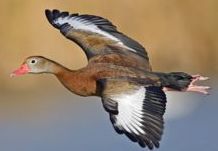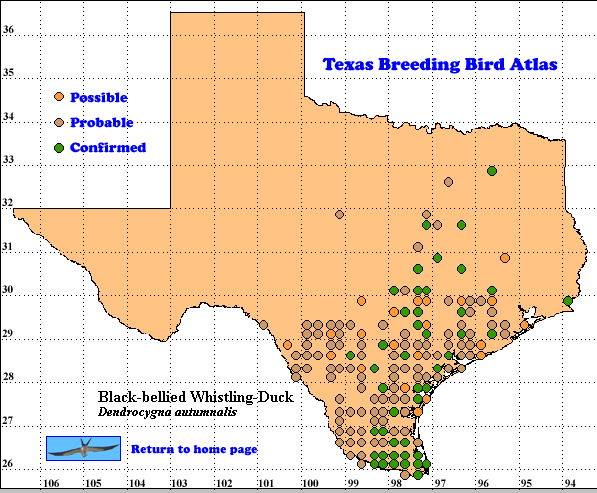America (including Trinidad) to northwest Argentina. The species is also established in central and south Florida and Cuba (Am. Ornithol. Union 1998, James and Thompson 2001). During the 1987-1992 field work of the TBBA project, atlasers found breeding evidence as far north as the 33rd parallel and as far west as the 101stmeridian. Of 325 breeding records, 23% were confirmed, 54% probable and 23% possible. Recently breeding has also been reported in Oklahoma (Arterburn 2004), Louisiana (Wiedenfeld and Swan 2000) and Arkansas (HHB).
SEASONAL OCCURRENCE The Black- bellied Whistling-Duck is both a migrant and a resident in south Texas. Some breeders in the Rio Grande delta are residents. Those nesting farther north are definitely migrants, moving south to feed in the delta’s corn and milo fields in the autumn and then migrating south of the Mexican border by December. The residents feed in harvested grain fields and congregate around livestock feedlots in winter. The migrants return in late March and spread out over south Texas, feeding in agricultural fields and Bermuda grass pastures.
Breeding extends from late March to October ad occasionally November. Eggs have been collected from, May 3 to October 18, downy young July 4 to October 22, and grown young as late as December 20 (Oberholser 1974). At Santa Ana National Wildlife Refuge (NWR) the first eggs of the season were laid Match 23 in a nest box and these hatched May 6, 1992 (HHB). In Corpus Christi, the average first nest date was May 5 (Bellrose 1980). On December 19, 1995 a Black-bellied Whistling-Duck with two 7-week old young was observed in the La Sal Viejo area (HHB). The young probably hatched October 31 from eggs laid October 1. The resident birds apparently nest earlier than migrants, and have more choice of nest sites.
BREEDING HABITAT: The Black-bellied Whistling-Duck prefers to nest in a cavity over water, but it will nest in other elevated sites (chimneys, pigeon roost) and in good ground cover, where these birds make shallow bowl of dry grass (Harrison 1979). In one sample of 18 nest boxes over water, 89^ were used by Black-bellied Whistling-Ducks, which sometimes raised 2 clutches. Barn Owls (Tyto alba) were less frequent occupants. (HHB).
Black-bellied Whistling-Ducks lay large clutches of as many as 22 (usually 12-16; Harrison 1979) eggs, but egg loss is high. Temperatures above 40o C (103o F) kill developing embryos. When guarded nest boxes are used, those painted white reflect the heat and are 5-8o C (10-15o F) cooler than dark nest boxes ,during extremely hot days. Evaporation checks heat buildup in nest boxes placed over water, where disturbance is also reduced. (HHB). During droughts many of the female ducks lay in dump nests, few incubate and many nests are deserted.
Predators on eggs in unguarded nests include raccoons, opossums and snakes. Their disturbances also cause nest desertion as does the disturbances by other Black-bellied Whistling-Ducks, Barn Owls, woodpeckers, honey bees, ants, and humans.
STATUS. Texas is the primary breeding area for Black-bellied Whistling-Ducks in the United States; Breeding Bird Survey (BBS) observers found them on 51 routes in this state at relative abundances of 10-30 ducks per 40 km (25 mi) route along the central and southern coasts (Sauer et al. 2005). Three BBS routes in south Texas have multi-year averages of 46-50 ducks per year (Price et al. 1995). The distribution map produced from the BBS data is similar to the TBBA map. The species is considered uncommon to locally common. The breeding range is reported to have expanded northward in recent years (Lockwood and Freeman 2004), consistent with the difference between the TBBA map and that of Oberholser (1974).
BBS data for the period 1980-2005 suggests an average annual population change of about +2.2% (Sauer et al. 2005). This recent trend in combination with the large breeding population in Texas, suggests continuing population expansion in this and adjoining states is probable. The expansion has continued despite a hunting season in Texas with an annual take estimated in 1996 at 1500-2000 ducks (B. Sullivan pers. comm).
Text by Harold H. Burgess (Posted with updates 2007)
Literature cited.
American Ornithologists’ Union. 1998. Checklist of North American birds, 7th ed. Am, Ornithol. Union, Washington, DC.
Arterburn, J. W. 2004. Black-bellied Whistling-Duck (Dendrocygna autumnalis). In Oklahoma breeding bird atlas. pp. 60-61 (D. L. Reinking, ed.). University of Oklahoma Press, Norman.
Bellrose, F. C. 1980. Ducks, geese and swans of North America. Stackpole, Harrisburg, PA.
Bent, A. C. 1925. Life histories of North American waterfowl, part 2. U. S.Natl. Mus. Bull. 130.
Harrison, H. H. 1979. A field guide to western birds’ nests. Houghton Mifflin, Boston, MA.
James, J. D. and J. E. Thompson. 2001. Black-bellied Whistling-Duck (Dendrocygna autumnalis). In The birds of North America, No. 578 (A. Poole and F. Gill, eds.). The Birds of North America, Inc., Philadelphia, PA.
Lockwood, M. W. and B. Freeman. 2004. The TOS handbook of Texas birds. Texas A&M University Press, College Station.
Oberholser, H. C. 1974. The bird life of Texas, University of Texas Press, Austin.
Price, J., S. Droege, and A. Price. 1995. The summer atlas of North American birds. Academic Press, New York.
Sauer, J. R., J. E. Hines, and J. Fallon. 2005. The North American Breeding Bird Survey, results and analysis 1966-2005. Version 6.2 2006. USGS Patuxent Wildlife Research Center, Laurel MD < http://www.mbr-pwrc.usgs.gov/bbs>
Wiedenfeld, D. A. and M. M. Swan. 2000. Louisiana breeding bird atlas. Louisiana Sea Grant College Program, Baton Rouge.

